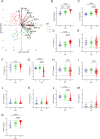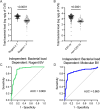Quantitative profiling of the vaginal microbiota improves resolution of the microbiota-immune axis
- PMID: 39905573
- PMCID: PMC11792376
- DOI: 10.1186/s40168-025-02039-4
Quantitative profiling of the vaginal microbiota improves resolution of the microbiota-immune axis
Abstract
Background: The composition of the vaginal microbiota is closely linked to adverse sexual and reproductive health outcomes, due in part to effects on genital immunology. Compositional approaches such as metagenomic sequencing provide a snapshot of all bacteria in a sample and have become the standard for characterizing the vaginal microbiota, but only provide microbial relative abundances. We hypothesized that the addition of absolute abundance data would provide a more complete picture of host-microbe interactions in the female genital tract.
Results: We analyzed cervicovaginal secretions from 196 female sex workers in Kenya and found that bacterial load was elevated among women with diverse, bacterial vaginosis (BV)-type microbiota and lower among women with Lactobacillus predominance. Bacterial load was also positively associated with proinflammatory cytokines, such as IL-1α, and negatively associated with chemokines, such as IP-10. The associations between bacterial load and immune factors differed across bacterial community states, but L. crispatus predominance was the only microbial community where higher bacterial load was not associated with higher proinflammatory cytokines. Total vaginal bacterial load was also a stronger predictor of the genital immune environment than BV by Nugent score, the current clinical standard, in the Kenya-based cohort and in a Uganda-based confirmatory cohort.
Conclusions: Our results suggest that total vaginal bacterial load is at least as strong a predictor of the genital immune milieu as current BV clinical diagnostic tools, supporting exploration of the vaginal bacterial load as a predictor of adverse reproductive and sexual health outcomes. Video Abstract.
© 2025. The Author(s).
Conflict of interest statement
Declarations. Ethics approval and consent to participate: All participants provided written, informed consent and the study was approved by the Kenyatta National Hospital Ethics and Research Committee (KNH ERC P778/11/2018), the London School of Hygiene and Tropical Medicine (LSHTM) Ethics Committee (Approval number: 16229) and the University of Toronto ethics committee (Approval number: 37046). Competing interests: The authors declare no competing interests.
Figures






References
MeSH terms
Substances
Grants and funding
LinkOut - more resources
Full Text Sources

